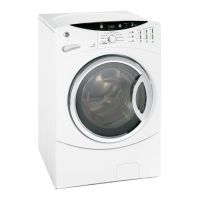Installation Instructions
INSTALLING THE WASHER
1. Runsome water from the hot and cold faucets to flush
the water linesand remove particles that might clog up
the water valve screens.
2. Removethe inlet hosesfrom the plastic bag.
3. (gO°elbow end)Carefully
connect the inlet hose
marked HOTto the outside
"H" outlet of the water valve.
Tighten by hand, then tighten
another 2/3 turn with pliers.
Carefully connect the other
inlet hoseto the inside "C"
outlet of the water valve.
Tighten by hand; then tighten
another 2/3 turn with pliers.Do not crossthread
or over-tighten these connections.
4. Connectthe inlet hose ends to the HOTand COLDwater
faucets tightly by hand, then tighten another 2/3 turn
with pliers.Turnthe water on and check for leaks.
5,
6,
Carefully move the washer to its final location. Gently rock
the washer into position. It is important not to damage
the rubber leveling legs when moving your washer
to its final location. Damaged legs can increasewasher
vibration. It man be helpful to spray window cleaner on
the floor to help move your washer into its final position.
NOTE:To reducevibration, ensurethat all four rubber
levelinglegsare firmly touching the flooEPush and
pull on the back right and then back left of your washeE
NOTE:Do not usethe dispenser drawer or door to lift
the washe_
NOTE:If you are installing into a drain pan, you can use
a 24-inch long 2x4 to leverthe washer into place.
With the washer in its final position, place a level
on top of the washer _ ../
(if the washer is installed
under a counter, _" _ _ //
the washer should not
be able to rock). Adjust
the front leveling legs _-_
up or down to ensure
the washer is resting
solid. Turn the lock nuts on each leg up towards
the base of the washer and snug with a wrench.
NOTE:Keepthe leg extensionat a minimum to prevent
excessivevibration.Thefarther out the legs are extended,
the more the washer will vibrate.
Ifthe floor isnot level or is damaged, you mag have
to extend the rear leveling legs.
18

